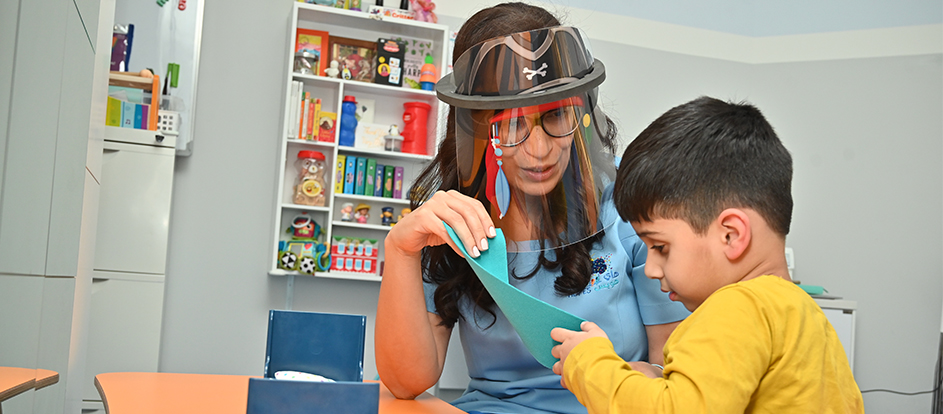
In speech and language therapy, sentence expansion is one of the most widely used building blocks that promotes language development. It consists of listening to the child’s spontaneous production of words and attempting to increase complexity by adding one more linguistic item to it. For example, if the child sees a car and makes a comment saying ‘car’ you can add: ‘yes, that’s a blue car’! Or in the different context the child is saying ‘car’ for a request you can simply acknowledge what he/she is saying and add ‘give me car’.
The rationale for this strategy to add one extra piece of information to your child’s speech is related to the fact that most children with a language delay present a similar level in the development of their receptive and expressive language skills. For example, if the child is saying one word, most likely his/her language processing—the amount of words he/she remembers and comprehends— is close to this word count. For example, if the child is saying one word, most likely his/her auditory processing and information retaining is close to 2-3 words. So, if the child says ‘car’ and the parent repeats ‘can I have a red car please?’. This is a grammatically correct sentence, however with too many linguistic concepts, and not very helpful strategy to help your child using longer sentences.
Besides the language aspect, there is a physiologic aspect to take into consideration. Talking and being able to produce speech is one the finest motor skills we can execute. Sometimes children are not physiologically mature enough to execute long strings of syllables and words. So, we need to be careful with our expectations. The most recommended approach is to observe, wait, and listen to your child, and then add one more meaningful item to it.
The language input children receive is crucial to foster language development. However, there is much that you can do to help your child’s language development, especially for the 2-3 years old. Research by Hadley, Rispoly, and Holt (2017) considers a strategy they called toy talk: the researchers provided three parent coaching sessions, where they are taught to respond the child’s interests in play, and to do engage in toy talk, or talking about toys, by referring to the object by name. For example, while playing with toy cars, the adult might model language by commenting, ‘It’s fast! He’s driving’. When using the toy talk strategy the adult might say, ‘The car is fast, the man is driving’.
Although the strategy sounds simple, the researchers found it yielded statistically significant results. Simply through the adults’ use of nouns instead of pronouns in the subject position, there is a clearer partition of these individual units during connected speech. When we say ‘It’s, he’s’ it sounds more as one unit instead of two ‘It is, he is’.
The authors also found that the toy talk strategy makes learning verb tense and agreement easier by forcing marking and helping children notice these small language elements in their parent’s discourse. For example, instead of saying: ‘Hop onto the horse’ or ‘Drink some water’ try saying using the toy talk strategy: ‘The cowboy hops onto the horse’, ‘The dog drinks water’.
In addition, toy talk has been found to be easy for adults to learn and use. In a nutshell, the use of too simple or telegraphic speech is not helpful, as it removes important context of the children’s input.
Another research by Frey and Kaiser (2010) took the idea of language expansions and applied into the play context. They called this strategy play expansions. Similar to sentence expansion, the premise of play expansions is to build on the play that children are already doing by first joining in with their play actions and then modeling a related play action that looks like either that of the child or a slightly more advanced one.
While performing the actions you may comment about what’s happening to nurture an immediate connection between what is happening (actions) and the language. For example, if your child is playing with the farm animals, let’s say your child is pretending the horse is eating apples, take another animal joining your child in play, imitate their action and describe: ‘The animals are eating!’. In addition, find ways to expand your play and continue to describe your action. For example, keep adding objects: put the animals in the barn and say, ‘let’s put the animals in the barn’. Use the toy in a different way: ‘the horse is jumping the fence’. Do something to the toy: ‘time to brush the horse’. Make toys interact with each other, while pretending the farmer is riding the horse says; ‘go farmer go’.
This strategy is also based on building language through your child interests. As adults we all learn faster about what we are interested in, and children are not different. In this way, play expansions help the child develop new ideas and new ways to engage with their favorite toys while listening to language associated with them. It is also an opportunity to practice imitation without prompts, helping children not become dependent on our prompts.
The researchers found that play expansions, over the course of 52 intensive sessions of around 5 minutes each, helped increase the toddler’s frequency, diversity, and complexity of play actions. It is important to note that all children had limited play skills at the beginning of the study, but they were able to imitate motor actions.
The authors also found that children rarely imitated the actions immediately but used them later in the session (delayed imitation). Delayed imitations also often occurs in language expansion. So, if your child does not imitate your actions right away do not worry about it. Usually, it takes some time for them to process a new idea, and they are much more likely to imitate an action or sentences later when there are no pressures.
Remember to have fun with your child! This is the most important ingredient for success. There is a significant amount of scientific evidence showing that the number of synapses in the brain during functional and positive interactions are significantly higher, in another words we learn faster when we are having fun and when the activity is functional.
High Hopes’ speech and language therapists are experienced in building your child’s language skills and are happy to answer any questions you may have. Contact us today to learn more.
Sources:
- Hadley, P.A, Rispoli, M., Holt, JK. (2017) Input Subject Diversity Accelerates the Growth of Tense and Agreement: Indirect Benefits From a Parent-Implemented Intervention. Journal of Speech, Language, and Hearing Research, JSLHR-L-17-0008
- Frey, J.R., & Kaiser, A.P. (2010). The use of play expansions to increase the diversity and complexity of object play in young children with disabilities. Topics in Early Childhood Special Education.





